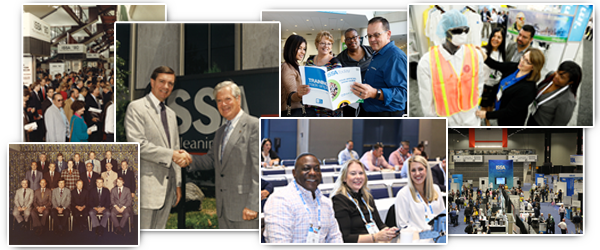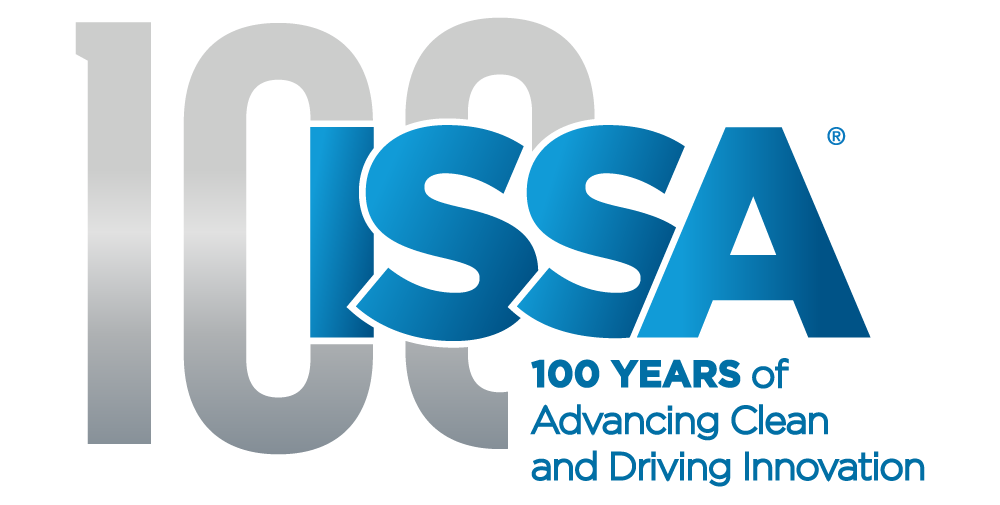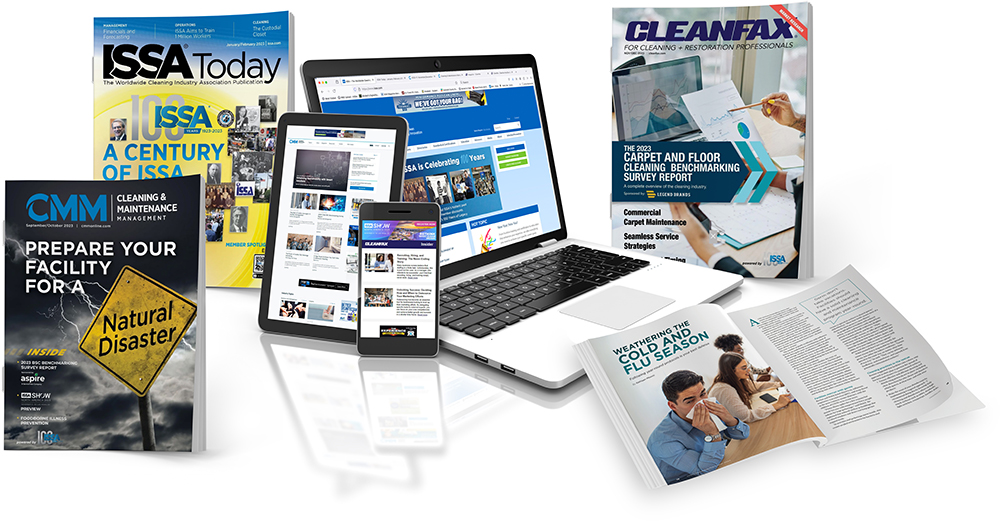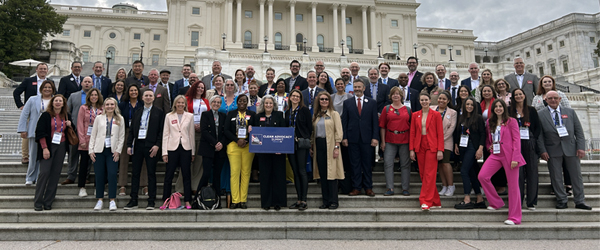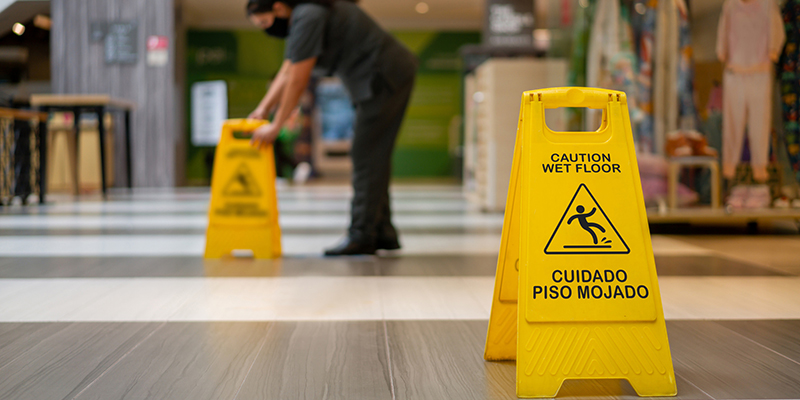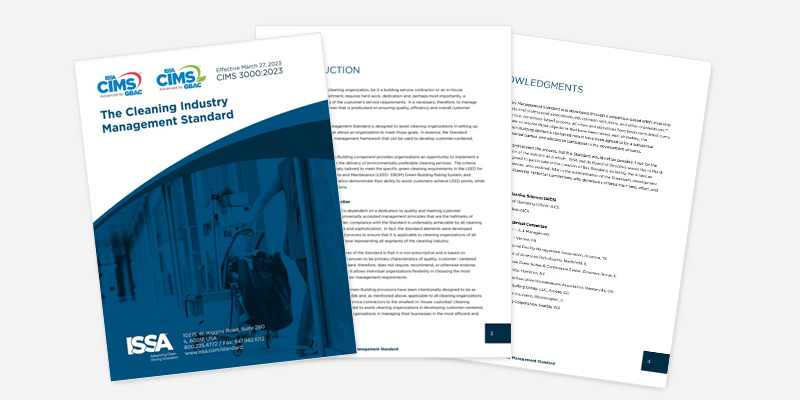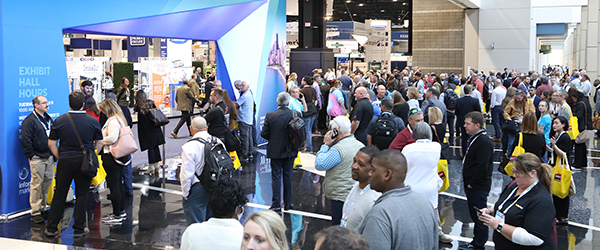The State of the Industry (Revisited)
We are more than halfway through 2020 and we find ourselves in a polar opposite situation of where we expected to be from the last State of the Industry report published in the January/February issue of ISSA Today.
It would be redundant of me to mention the details of what we are all going through and have experienced in the past several months. You know the details and have experienced the ups-and-downs of running a business or managing a facility during the COVID-19 pandemic.
My work as the editorial director of ISSA Media has amplified tremendously because of the sheer volume of increased editorial coverage of this global issue, from breaking news to feature articles and industry guidance on cleaning and disinfecting with our print, digital, and multimedia platforms.
As an example, the Global Biorisk Advisory Council® (GBAC®) STAR accreditation program for facilities (www.gbac.org) has gone global and is impacting the lives of everyone as buildings reopen and people strive to get back to business. The GBAC Fundamentals Online Course was created to provide technical expertise to all cleaning professionals worldwide.
In my last State of the Industry report, featuring the expertise of the ISSA board of directors, we concentrated on typical or “normal” challenges in the cleaning industry. Normal has changed. The future, although somewhat predictable according to some experts, sits on an unstable horizon for many of us.
It’s time for another State of the Industry report, concentrating on business and operation challenges during the COVID-19 pandemic and also the future. In this report, you will benefit from the guidance provided by these ISSA board of directors:
- Matt Vonachen, Vonachen Group
- Ailene Grego, SouthEast Link
- Ken Bodie, Kelsan Inc.
- Paul Barrett, North American Corp.
- Paul Goldin, Avmor
- Andy Clement, Kimberly-Clark Professional.
The COVID-19 pandemic has abruptly changed, and perhaps permanently altered the lives of everyone, virtually overnight. How would you rate the response of the global cleaning industry as a whole to this crisis, and why?
Matt Vonachen, ISSA building service contractor director
This pandemic caught the entire country off guard. We were not prepared for what was coming. That being said, I think the cleaning industry has responded positively and we now see the results.
Manufacturers didn’t have the inventory of supplies to deal with the challenges of a pandemic. The distribution supply chain was completely disrupted. But the manufacturers and distributors worked aggressively to respond. Cleaning contractors shifted gears quickly to high touch point (HTP) and electrostatic disinfecting. Our industry has truly been on the front-line in manufacturing, distributing, and providing the service to keep America safe.
I think the face of cleaning has changed. Cleaning, sanitizing, and disinfecting will be a higher priority in everyone’s lives moving forward.
Ailene Grego, ISSA distributor director
If I had to give a score, 1 being the worst and 10 being the best, I’d give our industry an 8. I think that as a whole, our industry rose to the occasion and we did everything in our power to provide guidance, supply products—as best as our supply chain could, given the circumstances—and adapt to unprecedented disruptions and changes to our way of doing business.
Ken Bodie, ISSA president
I would rate the industry as a 10 in our response to this pandemic. Manufacturers, distributors, and building service contractors have all stepped up their game to help our customers remain healthy and safe.
Historically, our industry has always been behind the scenes with very little recognition. COVID-19 has everyone thinking first and foremost about hand hygiene, disinfecting, and cleanliness. Hopefully, that will be the “new normal” and our industry will finally get the respect it deserves.
Paul Barrett, ISSA distributor director
The pandemic hit hard and fast without discrimination. It created significant disruption and displacement in our day-to-day lives, while altering our thoughts and actions around cleaning, disinfecting, and social interaction.
The supply chain response has been more than challenged and thus not prepared for such an onslaught of global demand. By the same token, manufacturers don’t have the ability to flip a switch to meet this magnitude of unplanned demand. That being said, in relatively short order, we saw alignment and prioritization to first responder needs.
Manufacturers are rethinking their supply chain capabilities and readiness and they’re planning for a permanent paradigm shift. Distributors, BSCs, ISPs, and others are redesigning their models to be more consultative to end users who need solution providers. We can’t operate within the past paradigm.
Where we have seen a fast and timely response to how businesses assess their COVID-19 preparedness is through ISSA’s GBAC division and the GBAC STAR® accreditation program. Combining GBAC with solutions from manufacturers, distributors, BSCs, and others, can provide an organization with a better employee peace of mind.
Paul Goldin, ISSA past president, international director
These are certainly unprecedented times for the global cleaning industry, whether you are a manufacturer, distributor, service provider, or property manager.
In general, I would say that the cleaning industry has responded quite well despite significant supply chain issues
We have all had to adapt and pivot in order to best support customer needs while, at the same time, ensuring that our working environments are safe for our valued employees.
Andy Clement, ISSA manufacturer director
I am so proud of the way our industry has responded to the pandemic. Through all the uncertainty, we’ve come together to do what we do best: Help people feel safe and healthy in their surroundings.
Our unique knowledge and expertise, as well as our products and services, have been needed like never before, and I think we have risen to the occasion.
There is still much to be done, however. From manufacturers to distributors to cleaners, we all play an important role in promoting hygiene and ensuring people feel safe and confident as society reopens.
Programs like the GBAC® STAR accreditation and the Fundamentals Online Course, with its corresponding Empowering Our Essential Heroes scholarship, are perfect examples of initiatives coming from our industry that are helping people get the knowledge and tools they must have to make facilities safer.
How have manufacturers and distributors stepped up in response to the COVID-19 pandemic?
Vonachen
My experience has been that most manufacturers and distributors have stepped up to change and adapt to the needs the pandemic demanded.
Increasing production, shifting manufacturing capabilities to make more of the products needed to deal with the pandemic, and other tactics have been demonstrated. Distributors have leveraged all their capabilities to get products to essential facilities and industry segments, such as hospitals and BSCs, by prioritizing their inventory and shipments.
Grego
Manufacturers work countless hours sourcing raw materials and making products not previously in their mix, such as hand sanitizers, soaps, face shields, masks, misters, foggers, and more.
Distributors have had to add and source those same items, and often prepay for them at much higher prices than before the pandemic hit. Both are spending a great deal of time working with each other to answer the countless inquiries about deliverability.
We have also worked together to be able to provide the most up-to-date information and guidelines for a safe reopening.
Bodie
Obviously, several manufacturers have seen unprecedented demand for critical items such as disinfectants, hand sanitizers, gloves, masks, wipes, electronic sprayers, and more. This demand has strained raw material providers, required extra production shifts, and demanded better communication between manufacturers and their distributors.
Distributors pivoted to focus on critical items to replace lost business due to the shelter-in-place requirements that involved almost every state.
Barrett
On the manufacturing side, those who are more domestic in their supply chain are faring better than those relying on a global supply model. Manufacturers with larger-scale operations have greater resources to pull from, but even then, they have struggled to meet the current unprecedented demand.
Even the sanitary paper shortage reflected retail buying of a panic nature tied to consumer uncertainly and fear. What is unclear is the impact of the office worker shifting—short or long term—to work at home or work from another location versus a centralized corporate office. This would have an impact on how and where products are procured, as well as a shift between away-from-home brands versus consumer retail brands.
Beyond sanitary paper, all manufacturers of hand sanitizer, disinfectants, disinfectant systems, wipes, and PPE have struggled to meet the unprecedented demand leading to product allocations by channel, by customer, and by individual order.
As we sit today, the manufacturers’ overall supply chain is starting to see some recovery, but we’re looking at year-end before we see enough supply to support demand.
To this end, the door has opened for other suppliers, many non-traditional, such as distilling companies producing hand sanitizer, to emerge. It has created a market for others to take advantage of by touting product efficacy that is simply not accurate or completely false.
Distributors are working to balance, manage, and prioritize their customer demands that have produced accelerated needs for cleaning, disinfecting, and PPE products from all channels and all customers.
Distributors are pivoting to be a total solution provider around education, site evaluations, identifying the proper products and systems throughout a business—and not just the washroom—while aligning the entire customer’s organization versus just procurement.
Goldin
As a manufacturer, we have had to be extremely flexible in order to deal with the various changes that have come up and continue to arise.
We constantly have to look for alternatives to raw materials that are in scarce supply and adjust production schedules based on the availability of raw materials.
Sometimes, we do not even know what raw materials will arrive and when they will actually be at our facility, so we really need to be on our toes.
More importantly, we need to be extremely responsive and supportive to our customers and provide solutions they need, especially in these trying times.
Clement
As a result of the COVID-19 pandemic, almost all businesses have been forced to pivot and flex in ways we never thought possible.
From a business standpoint, manufacturers have had to completely revamp their supply chains. Adding capacity, changing sourcing strategies, and streamlining and prioritizing production have all been critical as we work to step up and provide desperately needed products.
We’ve also been forced to quickly figure out how to effectively communicate with customers in a digital-first world. Distributors have been challenged to prioritize critical end-use customers and flex their own supply chain to start purchasing new products that previously weren’t as popular, such as masks, hand sanitizers, and wipes.
From an outreach standpoint, I have been proud to see the many ways our industry has come together to take care of our own. As soon as the crisis hit, we at Kimberly-Clark knew we had to do something to step up and support our first responders who work tirelessly behind the scenes to help other essential businesses run safely, putting their own health and safety at risk. Together with ISSA and GBAC, we’re providing scholarships to help cleaning organizations provide critical training on infectious disease prevention and control measures for their employees at no cost.
Looking at the future—both short and long term—what do you see, as far as changes and adjustments, that the global cleaning industry, especially BSCs and ISPs, must embrace?
Vonachen
There will be a new norm for preparedness. Disinfecting and sanitizing will become part of a standard scope. Society will have a greater respect for cleaning, higher expectations will evolve, and new standards will be set for building cleanliness. Contractors will need to train their personnel in new techniques.
Grego
We are on a task force for a prominent university to discuss protocol for reopening. Their plan (although not formally approved yet) is to have a modified reopening. Some of the changes they are discussing include:
- Temperature checks before entering the building
- Hand sanitizer at every entryway
- Masks required
- Social distancing required
- Around the clock disinfection
- One student per 150 square feet, with staggered attendance, including online learning on days they are not in class
- One person in the restroom at a time.
Recreation center: Four hours open, then two hours disinfection, around the clock
Buses: One student every other seat, with the driver disinfecting each time it is empty, with buses cleaned and disinfected at night.
It seems most schools and businesses are still shaking their heads about how to create the best protocol since this is uncharted territory. Most are waiting for someone to set up a protocol they can follow. Nobody has made a final decision about any of this yet.
Bodie
The “new normal” will require all of them to offer disinfecting services, infection prevention analysis, and advice to all of their customers on how to keep their occupants healthy and safe while at work.
Barrett
An unknown, at this time, is what does “return to work” really look like and what impact will that have through the traditional model of support. Distributors now need to think about how they’re going to manage customers who may have employees now working in part-time or full-time at-home offices. What solutions are needed to meet the new “hybrid” customer needs? The relationship between distributors and ISPs/BSCs will be critical.
Goldin
The overused term the “new normal” would certainly apply here. As businesses open up more and more, we all have to adapt our product and service offerings to meet and exceed the needs in this new reality. This would include enhanced cleaning and disinfection programs and practices with the appropriate PPE and training. Third-party programs will play a very important role in adding value for ISPs and BSCs in the eyes of their customers.
Clement
ISPs and BSCs have always been one of the first lines of defense when it comes to infection and disease prevention. The only difference now is that it is on everyone’s minds and therefore a priority. This means facilities and cleaning companies are going to have to go the extra mile to ensure patrons feel safe as places reopen. Visual cues that a facility has been cleaned and sanitized will be more important than ever.
Additionally, ISPs and BSCs must ensure that their employees are properly trained on new or improved cleaning and disinfecting techniques. They will also need to incorporate new products and protocol.
How will equipment and product innovation impact post-COVID-19 recovery efforts by the cleaning industry?
Vonachen
Innovation is going to be huge. Entrepreneurs are working feverishly to create solutions.
Imagine a product that can be sprayed on a high touch point surface that will create a safe surface for months. Robotic vacuums and electrostatic sprayers will be standard tools.
Grego
We’ve seen a tremendous surge in purchases of misters, foggers, and the use of hypochlorous acid (HOCl) as a non-toxic disinfectant. The guidelines set forth for reopening businesses include frequent disinfection, which increases cost and labor, especially if you are doing it correctly. Not only is HOCl cost-effective, but it is also completely non-toxic and safe if ingested.
Misting and fogging quats, found in traditional disinfectants, can be toxic and ineffective (depending on the product you are using and whether you are using the proper PPE).
With misting HOCl, there is a faster kill time and no rinsing is required, so the savings are substantial. I can see this really taking hold as people become more and more aware of the benefits.
Equipment manufacturers are now adding misters to their current equipment or making stand-alone units as they understand the demand is higher than the supply chain can manage. Most issues with this type of equipment are due to our dependency on importing parts and equipment from Asia.
Bodie
Electrostatic spraying will become routine for all buildings. We have already seen the entrance of new competitors to this market for both the machines and the chemicals.
Goldin
Product innovation will not only continue to evolve but will likely happen at a much more rapid pace then what we have seen in the past. From automated equipment to new and efficient applicators to disinfection products with broad bacterial, virucidal, and sporicidal claims, and faster dwell times, we will see improvements in our processes.
Clement
Disruption is often a catalyst for innovation, and this pandemic is no exception.
I’m anticipating that there will be no shortage of new or improved products and equipment coming from our industry in the coming months. Moving forward, I think we will see it from current suppliers as well as new ones.
As far as impact goes, I think it’s a whole new world with opportunity. If you aren’t looking to innovate now, you should be.
What will also be interesting to see is innovation in how our industry goes to market. In my opinion, the ability to reach customers digitally is no longer optional.
What additional advice or guidance do you have for the global cleaning community now and after the pandemic?
Vonachen
Get involved with ISSA, your global cleaning industry association. This will be your resource for the new world. Embrace new solutions such as offered through GBAC.
Grego
We have been saying this for years and I think now people will finally listen. Cleaning and disinfection are critical to the health and well-being of each individual who enters your facility, and the professional cleaning technician staff should be appreciated for their contribution to your safety. They are the real heroes.
People need to invest in the education of their employees because, although they may have been doing the job for many years, technology, chemistry, and protocol change over time.
Bodie
Thank goodness ISSA had the foresight to merge with GBAC just months before this pandemic hit.
Facilities are applying for and implementing GBAC® STAR accreditation and cleaning organizations and technicians are taking advantage of GBAC training programs.
Distributors will also be called upon to help customers assess their current cleaning and disinfecting practices to best protect their employees and customers.
Hopefully, the “new normal” will have all facility managers thinking about ways to keep their facilities clean and healthy to best serve their employees and customers.
Barrett
I think we can all agree that the world of cleaning has forever changed, and it has a global “front seat” in our everyday lives.
The need for ongoing education, awareness, access to products, and behavior changes will be our “new normal.”
The expectations of distributors, BSCs, ISPs, and others will be broader in scope and manufacturers will need to evolve their supply chains and use innovation as a catalyst to create products that clean more effectively and provide greater consumer confidence in the effectiveness of what clean really means.
Goldin
It would be an understatement to say that this pandemic has “changed the way the world views cleaning.” Proper cleaning, hygiene, and disinfection protocols will be more thorough than ever before.
I would also suggest that this will not fade away. It is abundantly clear that proper hand hygiene along with enhanced cleaning and disinfection programs are here to stay.
Clement
COVID-19 is a once-in-a-lifetime occurrence that will permanently change the way people work and live.
The effects on our industry will be lasting. There is no going back to the world we knew.
Now is our time to rise to the challenge. We must respond to the call to be agile and stay relevant to customers. And not just during the crisis, but also in the future.
Our industry is no longer hidden in the background. We are noticed. We are essential.
We must partner together like never before to help people feel safe and confident, reinforcing new hygienic behaviors, and working to ensure they become standard and lasting.



